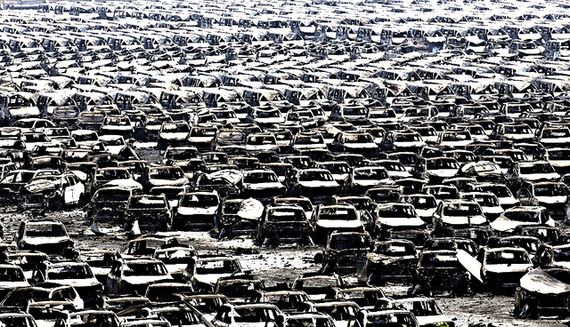The destruction in Tianjin came suddenly, with an August 12 explosion so severe that it could be seen from space, so immense that it left a crater in this Chinese port city and killed more than 100 people.
While the midnight blast delivered a swift and irrevocable blow, any definitive understanding of what caused it has been painfully slow. Authorities report that more than 100 tons of sodium cyanide were present at the site, along with toluene diisocyanate, ammonium nitrate, potassium nitrate and calcium carbide. Thousands of Chinese citizens were evacuated from the port area, as rescuers in gas masks and protective gear attempted to manage the environmental crisis. In Tianjin, the next thing to fear was rain -- rain that could cause new chemical reactions and release more deadly gases and toxins into the air and groundwater.
The tragedy in China has drawn comparisons to the 1984 Bhopal disaster, and the stunning images of its aftermath have evoked memories of the September 11 terrorist attacks in the United States. It has also underscored the silent catastrophe of China's failed environmental policy, where according to one new study from Berkeley Earth, an estimated 4,400 people die every day from air pollution-related causes.
But this is by no means only China's problem. What really happened in Tianjin is the result of a creeping environmental disaster unfolding across the globe, particularly in Southeast Asia, and it reflects the magnitude of the challenge that the leaders of the 10 ASEAN nations face as they seek to balance both economic growth and natural resource protection. According to a 2013 World Bank report on climate change, Southeast Asian nations face disproportionate impacts in terms of sea-level rise, precipitation, related food insecurity and power challenges, and a host of other impacts. The Mekong delta, along with those of the Irrawaddy and Chao Phraya, are especially at risk as stresses to their ever-growing urban populations increase. These nations include Malaysia, where illegal and unregulated bauxite mining raises fears of radioactive contamination in the region of Pahang. While regulated and closely monitored bauxite mining operations are largely considered safe and sustainable, in Malaysia this has not yet become the case. Largely due to repeated failures to enforce environmental and social safety standards, bauxite, much of which is sent to China for aluminum extraction processes, has leaked into water samples and left its toxic red dust in the wind, the sea, and the homes of villagers, resulting in serious health consequences for the population and the contamination of marine life. Meanwhile on Borneo Island, the lucrative global demand for palm oil is implicated in the nation's growing deforestation and wildlife management challenges.
These threats also include environmental crimes that generate an estimated $23 billion per year, according to the UN Office on Drugs and Crime. The upcoming ASEAN discussions to be held in Kuala Lumpur in September will be focused on elevating environmental crime -- wildlife and timber trafficking among them -- to the status of transnational crime. ASEAN will address a constellation of factors that impact biodiversity, water resources and other factors that include rapid economic development at the expense of environmental protection and policy, poor enforcement of those policies, and the contextual arc of climate change. But even as they do, their trading partners -- including China, as well as the EU and Western leaders -- need to cooperate on environmental issues. The importance of prioritizing these climate issues can't be overstated.
While other threats to these nations and their trading partners and investors do draw attention, the link between environmental crime and those threats -- including the funding of terrorist organizations -- may be more subtle. Protecting a sustainable future in Southeast Asia further depends on the affirmation and support of their counterparts in global trade. The overtures of British Prime Minister David Cameron during his July visit to Singapore focused on security and corruption, democratic reforms and infrastructure investments. But Cameron -- who also visited Vietnam, Indonesia and Malaysia -- just like other leaders, demonstrated far less concern for the threatened habitats of Southeast Asia, or the impacts of extraction and harvesting operations in one of the world's most fragile and biodiverse regions.
Even as a stunned China tends to the unthinkable in its own environmental consequences, it must begin to rethink the economic development priorities of the future. With bilateral trade between China and ASEAN countries expected to reach $500 billion by the end of this year, that future is inextricably linked with the future of Southeast Asia. Indeed, the ASEAN bloc is China's third-largest trading partner, and examples include the first joint Malay-Sino industrial park -- in the state capital of that same Pahang Province where the toxic red dust of bauxite mines, often located in residential and school districts, contains arsenic, beryllium, cadmium, chromium, lead, manganese, mercury, nickel and other naturally-occurring radioactive materials. Each ton of aluminum destined for China requires four to five tons of bauxite, and produces three tons of toxic red mud that leads to increases in respiratory and skin inflammation symptoms in the affected communities, explains Dr. Hezri Adnan. For its part, Malaysia's government must enforce necessary health and safety guidelines and closely monitor the industry, which will remain a hazard to the environment and population if left unregulated.
Ultimately, what China has so painfully learned in three decades of repeated regulatory and policy failures, and the lack of meaningful transparency surrounding it, has resulted in the tragic search for who is responsible and how they should be held accountable. That is exactly what ASEAN countries need to address now, and ensuring that environmental violations are treated as transnational crimes is a move in the right direction.

